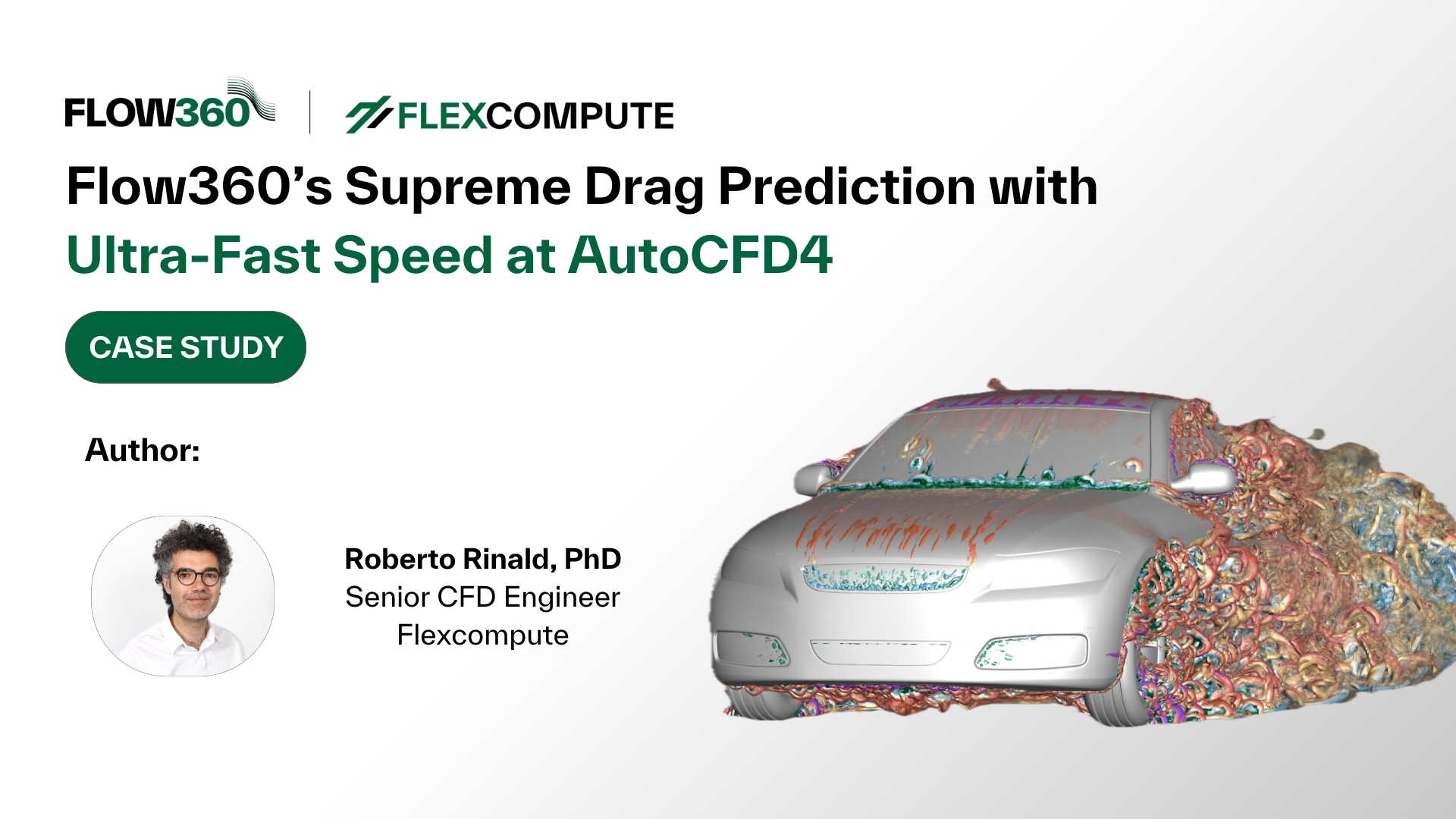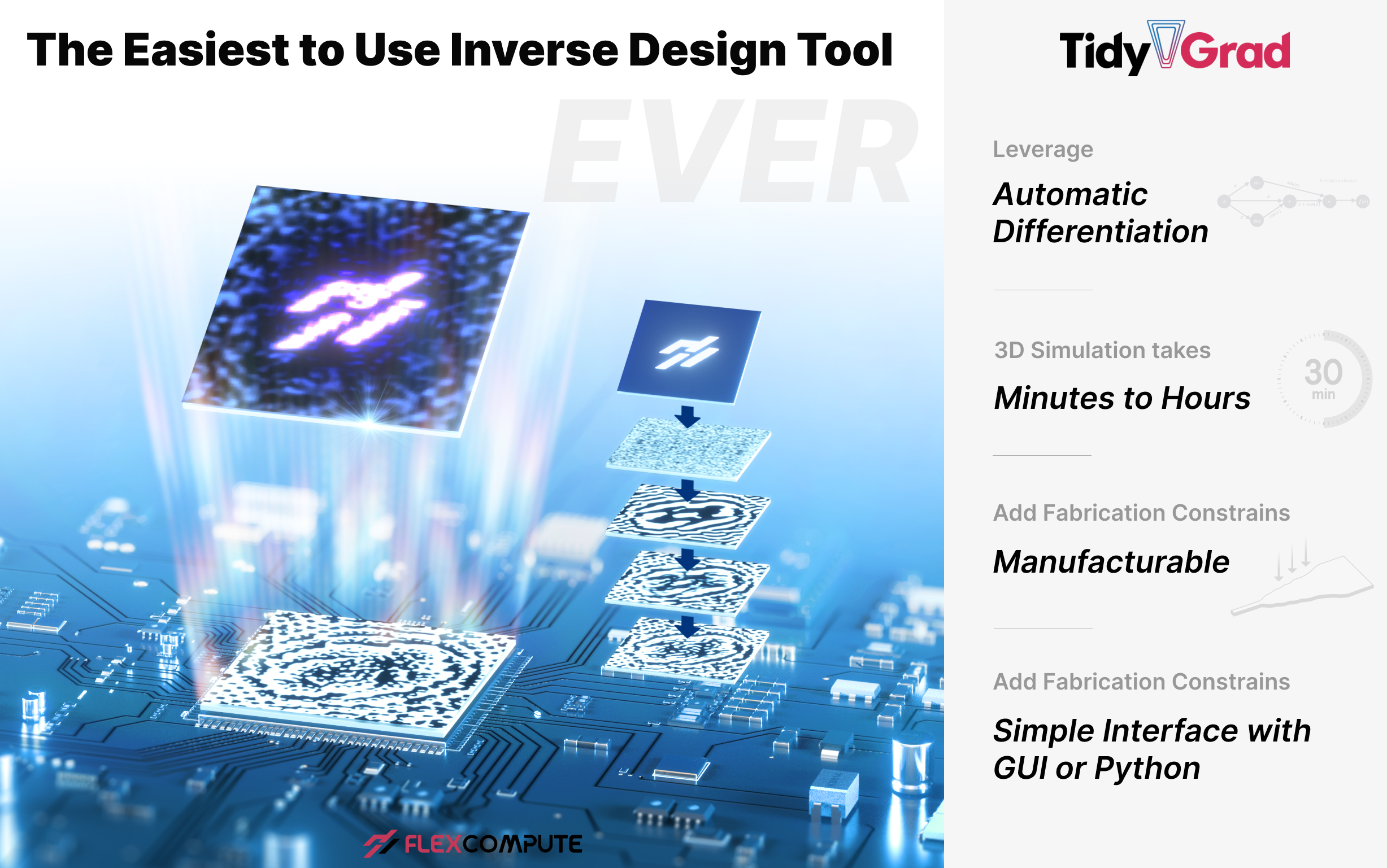Flow360’s Supreme Drag Prediction with Ultra-Fast Speed at AutoCFD4
“In our pursuit of excellence, we don’t compromise one aspect to enhance another.” – Qiqi Wang, Co-founder of Flexcompute and architect of Flow360
At Flexcompute, we live by this philosophy. During the Automotive CFD Prediction Workshop (AutoCFD4), Flow360 showcased its exceptional ability to deliver world class speed and accuracy—simultaneously.
AutoCFD is an international forum that brings together leading OEMs, universities, and CFD practitioners to benchmark simulations against wind tunnel data on standardized automotive geometries. It’s a proving ground—and Flow360 delivered.
While we’re proud to offer the fastest solver (see below), our mission goes beyond speed. Flow360 is an end-to-end platform that automates the tedious parts of simulation—geometry cleanup, meshing, setup, and reporting—so engineers can focus on what matters: innovation.
Benchmarking Flow360 on the DrivAer Model
We focused on the DrivAer model, a highly detailed and realistic geometry widely adopted for CFD benchmarking. Provided by the workshop committee, the standardized geometry, boundary conditions, and mesh ensure a level playing field. With comprehensive validation data—pressure taps, velocity probes, and PIV imagery—the DrivAer model is a rigorous testbed, and Flow360 passed with flying colors.
DrivAer Model
| Figure 1: Visualization of an isosurface of Q-criterion for DrivAer model |
Fast, Automated Meshing
Flow360 includes a powerful, feature-rich meshing tool. For AutoCFD4, it generated a hex-dominant mesh with 145 million nodes in just 60 minutes. This meshing workflow is easily automated using our Python API, enabling seamless integration into streamlined engineering pipelines.
| Figure 2: Visualization of the mesh for the DrivAer model generated with Flow360’s meshing tool | |
RANS Predictions by the Time You Finish Your Coffee (10 Min)
Traditional CFD tools take days to simulate realistic automotive geometries. Flow360 changes the game.
We completed a full RANS simulation of the DrivAer model in just 10 minutes on 48 A100 GPUs—without compromising accuracy. This was made possible by:
- A blended central/upwind scheme to reduce numerical viscosity
- A low Mach number preconditioner to enhance convergence
- An adaptive CFL strategy for stability and robustness
- User control over turbulence model coefficients, including an α₁ adjustment in the K-ω SST model (set to 0.4 to better capture separation over the roof)
The integrated force predictions from Flow360 showed excellent agreement with physical test data, with just 2 drag counts of difference—a level of accuracy rarely seen at this speed.
Figure 3: Comparison of integrated forces between Flow360 RANS and Test data having only 2 drag count difference
Scale-Resolved Simulation by the Time You Finish Lunch (37 min)
As OEMs increasingly adopt transient simulations for greater accuracy and faster design cycles, Flow360 continues to push boundaries. One major leap: support for Zonal Detached Eddy Simulation (ZDES) using the Deck-Renard shielding function, enhancing separation prediction in critical flow regions.
For AutoCFD4, we submitted a ZDES simulation using this approach. Total wall time: just 37 minutes, including both phases below:

Table 1: Simulation Timing Summary | *Wall clock time measured using 48 A100 GPUs
This two-phase ZDES approach done automatically in sequence with adaptive time-stepping:
- A coarse time step (5e-3 s, CFL = 50 on a resolved mesh zone) to flush the RANS solution for 0.75 sec—completed in 2 minutes on 48 A200 GPUs
- A fine time step (1e-3 s, CFL = 10) for the main ZDES run, averaged over the last 2 seconds—completed in 25 minutes on 48 A100 GPUs
All of this, without sacrificing fidelity. Flow360’s ZDES results match physical testing within 1 drag count, capturing complex flow physics that engineers can trust.
Figure 8: Flow360 ZDES’s excellent prediction of delta forces prediction between two DrivAer configurations with the Test data
Right Answers for the Right Reasons
Physically accurate flow features are essential for design optimization. Many CFD tools struggle to resolve complex flow phenomena, particularly around critical regions like the A-pillar and side mirror, where flow separation and downstream vortices significantly impact the pressure distribution on the side window. Flow360’s ZDES results, however, show close agreement with test data, validating its ability to capture the true physics of the flow.
This high level of accuracy continues along the symmetry plane of both the upper body and underbody, where Flow360’s pressure predictions align closely with wind tunnel data. Such consistency reinforces trust in the solver’s reliability for production use.
Even in the most challenging regions—such as the rear wake and underfloor—Flow360 delivers. The wake contours show excellent agreement with test results, clearly demonstrating that Flow360 captures not just trends, but the detailed unsteady structures that matter most to real-world aerodynamic performance.
Figure 5: Visualization of flow structure around A-piller and side mirror along with excellent agreement between Flow360 and Test data for pressure prediction on side mirror
Delta Prediction: Where It Counts in Design Optimization
In the production stage, the priority shifts from absolute accuracy to capturing aerodynamic deltas—the impact of design changes on performance. At this point, vehicle designs are largely frozen, and the focus shifts to fine-tuning specific components—such as mirrors, underbody panels, or wheel deflectors—to optimize efficiency. What matters most is the ability to reliably capture how each design tweak impacts overall drag performance.
One of AutoCFD4’s most important test cases was the front wheel arch deflector delta—a highly relevant real-world scenario given how often such features are refined late in the design cycle.
Figure 8: Flow360 ZDES’s excellent prediction of delta forces prediction between two DrivAer configurations with the Test data
Flow360 accurately captured both the magnitude and trend of the delta, enabling confident decision-making and reducing reliance on costly wind tunnel validation. It’s precisely why Flow360 is already trusted in production by leading automotive OEMs.
Real-World Validation: NIO Success Story
Flow360 isn’t just proven in benchmarks—it’s trusted in production. In collaboration with NIO Inc., we validated over 60 designs across SUVs and sedans. The results:
- Fastest Speed and Efficiency: Flow360’s simulation time is 10-100 times faster than traditional methods, completing complex simulations in just an hour on 8 L20 (10 mins on 8 H200)
- Unparalleled Accuracy: More than 94% of simulations show less than 3% deviation from physical wind tunnel tests, ensuring that design decisions are based on reliable data.
Many tools struggle in robustness and consistency across extensive test scenarios —Flow360 delivers.
In the example below Flow360 accurately captured the design delta Cd caused by a small change to air-intake. This was particularly challenging as it is located near the wheel well. With Flow360 you can have confidence in your results to make the right decisions.
Figure 9: Accurate prediction of delta Cd by Flow360 as compared to a competitor for a design change due to air-intake
And the Best Part? We’re Just Getting Started
Flow360 combines unmatched solver speed with high-fidelity results—redefining how automotive CFD gets done. But this is just the beginning.
Behind Flow360 is a world-class team shaping the future of simulation. We’re proud to be working with some of the most respected minds in the field—like Dr. Philippe Spalart, the pioneer behind the Spalart-Allmaras turbulence model; Dr. Mike Park, former NASA researcher and global leader in adaptive mesh refinement; and Dr. Roberto Della Ratta Rinaldi, former senior aerodynamicist at Aston Martin and McLaren, with over 15 years at the forefront of automotive aero analysis and methodology development.
Together, this team isn’t just evolving CFD—they’re accelerating it beyond anything the industry has seen. Flow360 enables interactive workflows at unprecedented speed, taking engineers from geometry to insight in hours, not days.
And there’s more ahead. In Q3 2025, we’ll be launching a major release focused on geometry, further simplifying simulation and introducing new levels of automation and intelligence into the workflow.
If you’re building the future, choose a partner that represents the future.
Experience Flow360—and see how fast innovation can move. Talk to an expert to learn more about Flow360.







